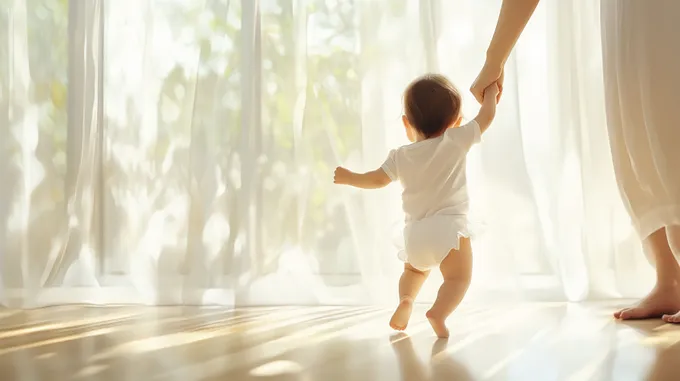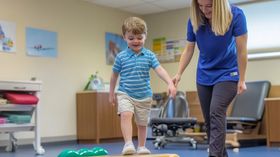Autism and Walking on Tippy Toes: Exploring the Connection
Exploring the complex relationship between autism and toe walking, and the therapeutic approaches that can make a difference
Updated December 5, 2024

Autism spectrum disorder (ASD) is a complex condition that affects communication, social interaction, and behaviour. One of the lesser-known yet intriguing characteristics associated with autism is the tendency for some children to walk on their tiptoes, often referred to as "toe walking."
As parents and caregivers navigate raising a child with autism, it's crucial to understand the connection between this unique gait pattern and the broader implications of the disorder. Let's explore ways to support our kids who toe walk and help them feel confident and comfortable.
» Explore shoes designed to address toe walking in kids with autism
The Link Between Autism and Toe Walking
Toe walking is a condition where a child walks on the balls of their feet, with their heels rarely or never touching the ground. While toe walking can occur in children without any underlying conditions, it is significantly more common in those diagnosed with autism spectrum disorder.
The reasons behind the increased occurrence of toe walking in children with autism are multifaceted and continue to be explored by researchers.
- Sensory Processing Differences: Children with ASD often experience heightened or reduced sensory responses, which can lead to a preference for walking on their toes. The sensory input from the soles of the feet may be perceived differently, leading to this gait pattern.
- Motor Control and Coordination Challenges: Autism can be associated with difficulties in motor planning, muscle tone, and overall coordination, which may contribute to toe-walking behaviours. [2]
- Proprioceptive Differences: Proprioception, the sense of one's body position and movement, can be impacted in those with ASD. This can result in a preference for toe walking to get more sensory feedback.
» Understand the connection between toe walking and ADHD
What Are the Consequences of Toe-Walking?
The implications of toe walking in children with autism go beyond just the physical aspect of their gait. Persistent toe walking can lead to a range of issues, including:
- Muscle Tightness and Shortened Achilles Tendons: The constant positioning of the feet on the toes can cause the calf muscles and Achilles tendons to become tight and shortened over time.
- Balance and Coordination Difficulties: The altered gait pattern can make it challenging for kids with ASD to maintain balance and coordination, affecting their overall mobility and physical development.
- Social and Emotional Consequences: Toe walking can draw unwanted attention and social stigma, potentially impacting a child's self-esteem and social interactions.
» Normal or not? When to worry about your kid toe walking
How Shoes Can Help
The choice of footwear plays a crucial role in managing toe-walking behaviours in children with autism. Since many ASD children experience intensified sensory responses, their shoes' texture, pressure, and fit can dramatically impact their comfort and walking patterns.
Traditional footwear often has seams, materials, and elements that may feel overwhelming or uncomfortable to sensitive feet. Even minor irritations that might go unnoticed by other children can trigger significant discomfort for those with autism, potentially reinforcing toe walking as a coping mechanism.
Here are some key factors to look for:
- Sensory-Friendly Materials: The shoes should be made of soft, breathable fabrics that don't irritate the senses. Conventional shoes often overlook this important detail.
- Extra Cushioning: More cushioning in the heel and sole can absorb the extra stress that walking on the feet puts on the foot, preventing pain and fatigue.
- Easy Fasteners: Simple velcro or elastic closures work better than complex laces or buckles for children with coordination issues.
- Ankle and Arch Support: Targeted support helps maintain proper foot alignment and gait for toe walkers.
- Flexible Soles: Shoes that bend and flex encourage a natural heel-to-toe rolling motion rather than staying up on the toes.
- Wide Toe Box: Ample room in the front of the shoe gives toes the freedom to move without restriction.
Consider all of these factors as shoes that focus only on posture correction without addressing sensory needs may actually increase toe walking as a coping mechanism for discomfort.
Recognising the Signs of Improper Footwear
Kids with communication challenges may struggle to tell you when their shoes are causing discomfort. Instead, they might show their distress through behavioural changes.
- Increased Toe Walking: Persistent toe walking, even with corrective shoes, could indicate inadequate support or comfort.
- Reluctance to Wear Shoes: Consistent refusal to wear shoes might signal discomfort caused by poor fit, irritating materials, or sensory issues.
- Foot Pain or Fatigue: Complaints of foot pain or tiredness after walking suggest insufficient cushioning or structural support.
- Balance Issues and Falls: Struggling with balance or frequent falls while toe walking may be linked to inadequate stability and support.
» Ensure every walk is comfortable with these toddler shoes
Other Treatments for Toe-Walking
A doctor might suggest some potential treatments for your child with significant toe walking.
- Sensory Integration Therapy (SIT): By improving body awareness, calming the nervous system, and developing motor skills, SIT helps children become more attuned to their bodies and the environment, reducing the need for sensory-seeking behaviors.
- Stretching and Strengthening Exercises: Physical therapy can help alleviate these tight muscles through targeted stretching and strengthening exercises. Regular practice of these exercises can lead to increased flexibility and a more normalised gait.
- Orthotic Devices: If structural foot abnormalities underlie toe walking, custom orthotics can provide the necessary support to correct these issues. When used with supportive footwear, orthotics can significantly improve foot alignment and gait.
- Visual Cues and Gait Training: Visual cues, such as coloured markers on the floor, can guide children in proper heel-to-toe walking. Supervised gait training sessions can further enhance motor control and balance development.
- Occupational Therapy: Therapists often use sensory-based activities to enhance body awareness and reduce reliance on toe walking as a sensory coping mechanism. Improving proprioception encourages a more functional gait pattern.
» Explore shoes for different stages of foot development
Creating a Supportive Environment
Supporting an autistic child who toe walks requires understanding that this behaviour is often normal and can be effectively addressed. Each child's experience with toe walking is unique, and their path to improvement should be as individual as they are.
The most effective approach combines supportive footwear with individualised therapies under the guidance of experienced professionals. You create an environment that supports their natural development and comfort by maintaining consistency while allowing your child time to adjust at their own pace.
» Discover footwear solutions for toe walking in autism
Disclaimer: First Walkers' information is intended for educational and informational purposes related to toddler footwear and feet. We encourage you to consider individual circumstances and consult qualified orthopaedists about specific conditions.






